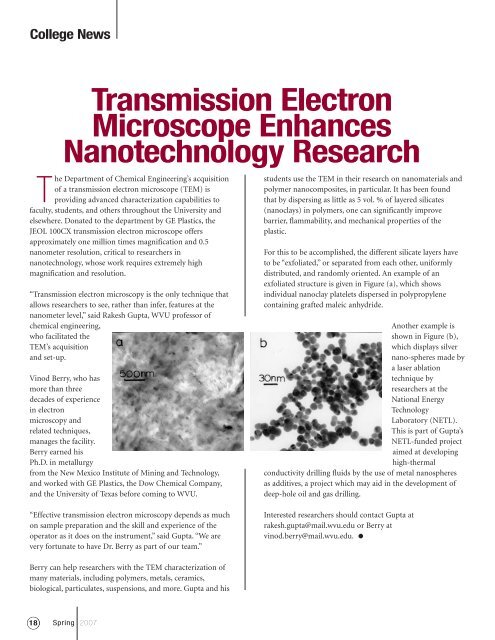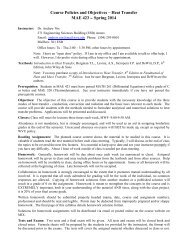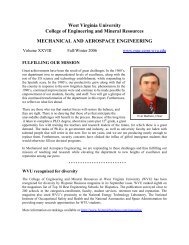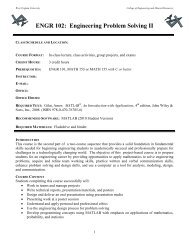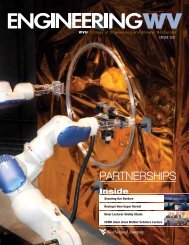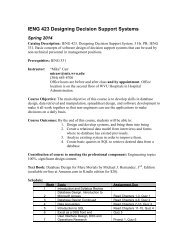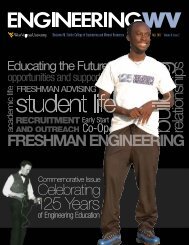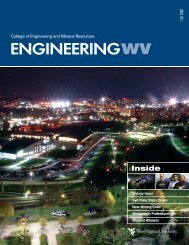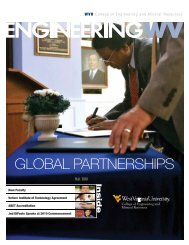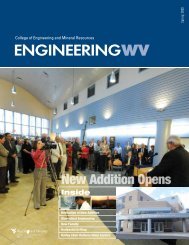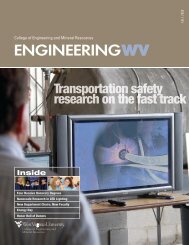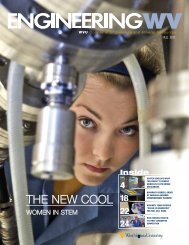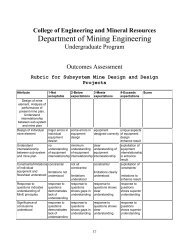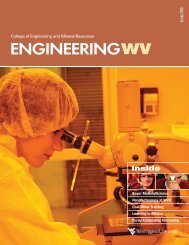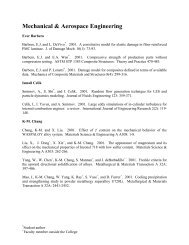70931, page 1-35 @ Normalize - WVU College of Engineering and ...
70931, page 1-35 @ Normalize - WVU College of Engineering and ...
70931, page 1-35 @ Normalize - WVU College of Engineering and ...
You also want an ePaper? Increase the reach of your titles
YUMPU automatically turns print PDFs into web optimized ePapers that Google loves.
<strong>College</strong> News<br />
Transmission Electron<br />
Microscope Enhances<br />
Nanotechnology Research<br />
The Department <strong>of</strong> Chemical <strong>Engineering</strong>’s acquisition<br />
<strong>of</strong> a transmission electron microscope (TEM) is<br />
providing advanced characterization capabilities to<br />
faculty, students, <strong>and</strong> others throughout the University <strong>and</strong><br />
elsewhere. Donated to the department by GE Plastics, the<br />
JEOL 100CX transmission electron microscope <strong>of</strong>fers<br />
approximately one million times magnification <strong>and</strong> 0.5<br />
nanometer resolution, critical to researchers in<br />
nanotechnology, whose work requires extremely high<br />
magnification <strong>and</strong> resolution.<br />
“Transmission electron microscopy is the only technique that<br />
allows researchers to see, rather than infer, features at the<br />
nanometer level,” said Rakesh Gupta, <strong>WVU</strong> pr<strong>of</strong>essor <strong>of</strong><br />
chemical engineering,<br />
who facilitated the<br />
TEM’s acquisition<br />
<strong>and</strong> set-up.<br />
Vinod Berry, who has<br />
more than three<br />
decades <strong>of</strong> experience<br />
in electron<br />
microscopy <strong>and</strong><br />
related techniques,<br />
manages the facility.<br />
Berry earned his<br />
Ph.D. in metallurgy<br />
from the New Mexico Institute <strong>of</strong> Mining <strong>and</strong> Technology,<br />
<strong>and</strong> worked with GE Plastics, the Dow Chemical Company,<br />
<strong>and</strong> the University <strong>of</strong> Texas before coming to <strong>WVU</strong>.<br />
students use the TEM in their research on nanomaterials <strong>and</strong><br />
polymer nanocomposites, in particular. It has been found<br />
that by dispersing as little as 5 vol. % <strong>of</strong> layered silicates<br />
(nanoclays) in polymers, one can significantly improve<br />
barrier, flammability, <strong>and</strong> mechanical properties <strong>of</strong> the<br />
plastic.<br />
For this to be accomplished, the different silicate layers have<br />
to be “exfoliated,” or separated from each other, uniformly<br />
distributed, <strong>and</strong> r<strong>and</strong>omly oriented. An example <strong>of</strong> an<br />
exfoliated structure is given in Figure (a), which shows<br />
individual nanoclay platelets dispersed in polypropylene<br />
containing grafted maleic anhydride.<br />
Another example is<br />
shown in Figure (b),<br />
which displays silver<br />
nano-spheres made by<br />
a laser ablation<br />
technique by<br />
researchers at the<br />
National Energy<br />
Technology<br />
Laboratory (NETL).<br />
This is part <strong>of</strong> Gupta’s<br />
NETL-funded project<br />
aimed at developing<br />
high-thermal<br />
conductivity drilling fluids by the use <strong>of</strong> metal nanospheres<br />
as additives, a project which may aid in the development <strong>of</strong><br />
deep-hole oil <strong>and</strong> gas drilling.<br />
“Effective transmission electron microscopy depends as much<br />
on sample preparation <strong>and</strong> the skill <strong>and</strong> experience <strong>of</strong> the<br />
operator as it does on the instrument,” said Gupta. “We are<br />
very fortunate to have Dr. Berry as part <strong>of</strong> our team.”<br />
Interested researchers should contact Gupta at<br />
rakesh.gupta@mail.wvu.edu or Berry at<br />
vinod.berry@mail.wvu.edu.<br />
Berry can help researchers with the TEM characterization <strong>of</strong><br />
many materials, including polymers, metals, ceramics,<br />
biological, particulates, suspensions, <strong>and</strong> more. Gupta <strong>and</strong> his<br />
18<br />
Spring 2007


